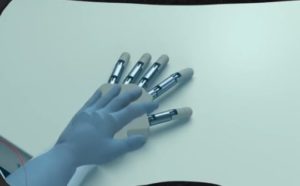Aug 14 2018
Phantom and Prosthetic Limbs
 One of the goals of prosthetic technology (replacement limbs for amputees) is to make the user feel like the prosthetic is part of their body – that they own it and control it (called embodiment). It is more difficult to control a limb that does not feel like part of your body, and users need to visually look at a prosthetic to see where it is. This is true of passive prosthetics as well as robotic ones.
One of the goals of prosthetic technology (replacement limbs for amputees) is to make the user feel like the prosthetic is part of their body – that they own it and control it (called embodiment). It is more difficult to control a limb that does not feel like part of your body, and users need to visually look at a prosthetic to see where it is. This is true of passive prosthetics as well as robotic ones.
I have written previously about researcher attempts to provide sensory feedback to robotic limbs. A new study adds to this growing knowledge about how embodiment works and how to hack the brain to make it happen.
The key to embodiment seems to be multimodal sensory feedback. If the brain sees and feels the same action, that is all that is necessary for the “ownership module” to kick in – that part of the brain that makes you feel as if you own the various parts of your body. The most primitive manifestation of this is the rubber hand illusion. If you have a rubber hand protruding from your sleeve as if it is your real hand, and you see the rubber hand touched while your real hand is touched (and therefore you feel it), this will create the temporary illusion that the rubber hand is your real hand. Obviously this is not practical for everyday use of a prosthetic.
In this study there were just two subjects, and the prosthetic limbs were not robotic. The researchers tried to duplicate the rubber hand illusion more strongly. They rigged the prosthetic limb with a stimulator that could stimulate the stump end of the nerve that would go to the index finger (the median nerve). They also gave the subjects virtual reality goggles. The system then stimulated the nerve while the VR goggle showed the index finger glowing. They did this in synchrony and in asynchrony as a control. For the synchronous visual and tactile stimulation, both subjects reported feeling as if the prosthetic limb was part of them.
More than that, however, was what happened to their phantom limb. Both subjects had a phantom limb sensation, a sensation that amputees have that they still feel and own a limb even though their limb is gone. This happens because the ownership module is still active, even though the physical limb is not there. However, the altered sensory feedback often creates the sensation that the phantom limb is smaller than the real limb. For these two subjects with a phantom hand, they felt as if their phantom hand was emerging from their stump, as if their forearm was missing (a phenomenon known as telescoping).
In this study both subjects not only felt as if they owned the prosthetic limb, they also felt as if their phantom limb extended back to normal size and merged with the prosthetic limb. This is exactly what the researchers hoped would happen.
So yet again it seems as if it is remarkably easy to trick the brain into embodying prosthetic limbs. All that is required is synchronous multimodal sensory feedback, such as vision and touch. Researchers are also experimenting with vibration to simulate proprioception (the sense of where the limb is) and force feedback to detect pressure.
So far all of the research indicates that the various sensory feedback techniques essentially work – they produce a convincing illusion that subjects own and control their artificial limbs. The term “illusion” might be a bit misleading here, but the reality is that our normal sensation of ownership and control is also a constructed illusion. These prosthetic techniques are just duplicating that normal illusion that is already part of the way our brains function.
So now we have established all the basic principles necessary for full neurological incorporation of prosthetic limbs (whether robotic or not). All we need now is incremental improvements in the technology itself. We are still a long way from fully bionic limbs, but the research is encouraging and shows there are no theoretical neurological limitations to getting there.






